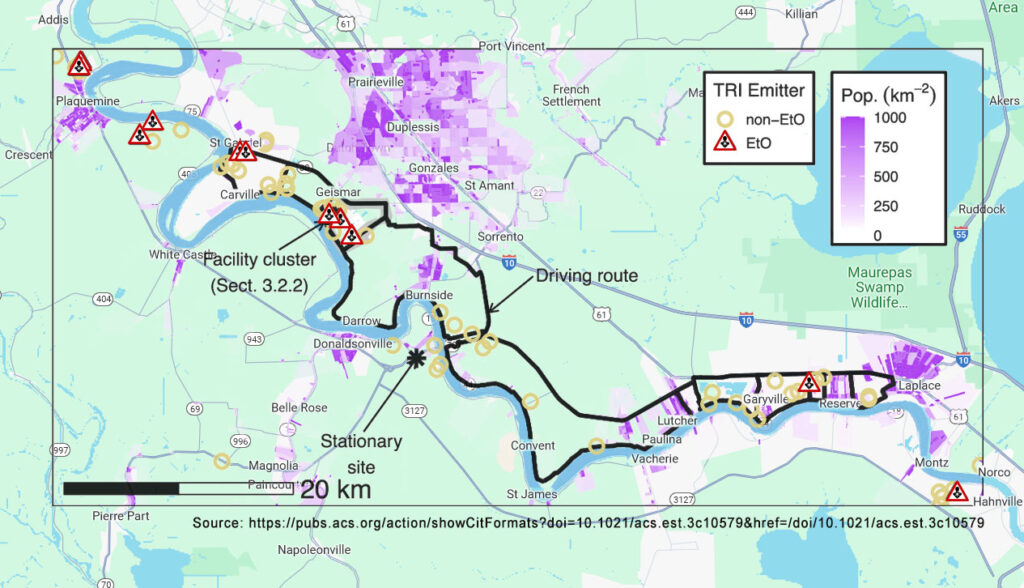
The recently released paper “Ethylene Oxide in Southeastern Louisiana’s Petrochemical Corridor: High Spatial Resolution Mobile Monitoring during HAP-MAP” in Environmental Science & Technology presents detailed findings on the ambient concentrations of ethylene oxide (EtO) in a heavily industrialized region of southeastern Louisiana. Here’s a summary of the key points:
Abstract
Focus: The study investigates ambient EtO concentrations using mobile monitoring methods.
Methods: In situ, fast (1 Hz), sensitive EtO measurements were conducted in February 2023.
Findings:
-Average mixing ratios were reported for a 75 km stretch of the industrial corridor.
-Mean and median aggregated values were 31.4 ppt and 23.3 ppt, respectively.
-Majority (75%) of 500 m grid cells had EtO concentrations above 10.9 ppt, which corresponds to a 100-in-one-million excess cancer risk.
-A small subset (3.3%) exceeded 109 ppt (1000-in-one-million cancer risk), mostly near EtO-emitting facilities.
-Plumes correlated with other gases, indicating potential emission sources.
-EtO concentrations for 13 census tracts were higher than EPA estimates.
Introduction
EtO Characteristics: EtO is a VOC used in the production of various chemicals and as a sterilizing agent. It is a known human carcinogen, associated with cancers like leukemia, myeloma, lymphoma, and breast cancer.
Emission Sources: Around 20% of U.S. EtO emissions are from sterilization operations, with 75% from petrochemical manufacturing. A significant portion of emissions are fugitive, from leaks in industrial equipment.
Health Risks: Non-occupational exposure is highest near EtO production and processing facilities. Southeastern Louisiana is a significant EtO emitter, with higher cancer risks linked to industrial air pollution, affecting marginalized communities disproportionately.
Methodology
Mobile Monitoring: Utilized commercial optical instruments for real-time EtO detection across the industrial corridor.
Spatial Analysis: Examined spatial patterns of EtO concentrations and compared census tract-level estimates with EPA’s modeled data.
Results and Discussion
EtO Concentrations: The study found high EtO concentrations, especially near emission sources, highlighting the need for precise, real-time monitoring to assess public health risks.
Comparison with EPA Estimates: The study’s findings showed higher EtO levels than EPA estimates, suggesting potential underestimation of exposure risks in existing models.
Conclusion
Significance: The findings provide crucial data on EtO levels in a key industrial region, emphasizing the importance of accurate, high-resolution monitoring for environmental health assessments and regulatory purposes.
This summary encapsulates the essence of the research, focusing on the main objectives, methods, findings, and implications regarding ethylene oxide exposure in Southeastern Louisiana.
What does this study mean for the residents of cancer alley?
The findings from the study on ethylene oxide (EtO) concentrations in Southeastern Louisiana’s petrochemical corridor have several important implications for the residents of “Cancer Alley”:
Increased Health Risks
Elevated Cancer Risk: The study found that a significant portion of the measured EtO levels in the region exceeded the thresholds associated with increased cancer risks. For residents, this means a heightened long-term risk of developing cancer, particularly types such as leukemia, myeloma, lymphoma, and breast cancer.
Chronic Exposure: Continuous exposure to even low levels of EtO, a known human carcinogen, poses serious health risks. The presence of EtO plumes far from emission sources indicates widespread contamination, increasing the potential exposure for a large number of residents.
Environmental Justice Concerns
Disproportionate Impact: The region, colloquially known as “Cancer Alley,” is predominantly populated by marginalized communities, including impoverished and Black neighborhoods. The elevated EtO levels add to the existing burden of industrial pollution that disproportionately affects these communities, raising significant environmental justice issues.
Inequity in Health Outcomes: Higher cancer incidence rates and other health issues related to industrial pollution in the area underscore the inequities in environmental health outcomes. The study’s findings highlight the need for targeted interventions and stricter regulatory measures to protect these vulnerable populations.
Regulatory and Policy Implications
Need for Stricter Regulations: The study suggests that current EPA estimates may underestimate the actual EtO concentrations and associated risks. This calls for a reevaluation of existing regulations and the implementation of stricter controls on EtO emissions to mitigate health risks.
Enhanced Monitoring: The successful use of high-resolution mobile monitoring in this study demonstrates the need for more widespread and regular monitoring of air toxics. Such efforts can provide more accurate data for assessing public health risks and informing policy decisions.
Community Awareness and Advocacy
Increased Awareness: The findings can help raise awareness among residents and local advocacy groups about the specific health risks associated with EtO exposure. This knowledge empowers communities to demand better regulatory protections and environmental health interventions.
Support for Legal and Advocacy Efforts: The data provides concrete evidence that can support ongoing legal battles and advocacy efforts aimed at reducing industrial emissions and protecting community health. For instance, it can strengthen cases against new industrial facilities that would contribute to further pollution in the area.
Long-term Health Monitoring
Health Surveillance: There is a need for ongoing health surveillance and studies to monitor the long-term health outcomes of residents. This can help in understanding the full impact of EtO exposure and other pollutants, guiding public health interventions and resource allocation.
In summary, the study’s findings underline the critical need for enhanced regulatory measures, better environmental monitoring, and targeted health interventions to protect the residents of Cancer Alley from the harmful effects of ethylene oxide and other industrial pollutants.
06/13/2024
(Credit – Healthcare Journal of Baton Rouge*)
*https://healthcarejournalbr.com/news/new-study-shows-cancer-alley-is-still-spewing-toxic-chemicals